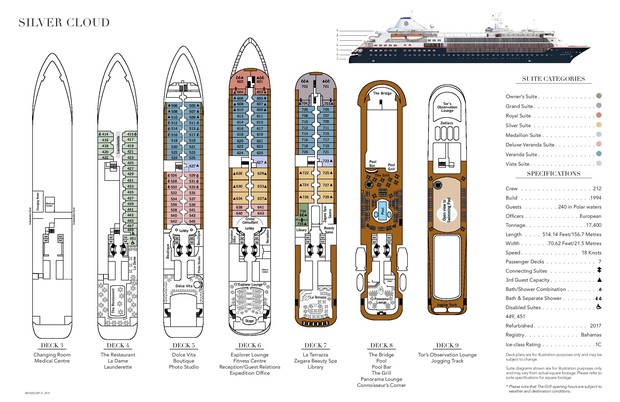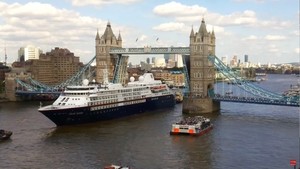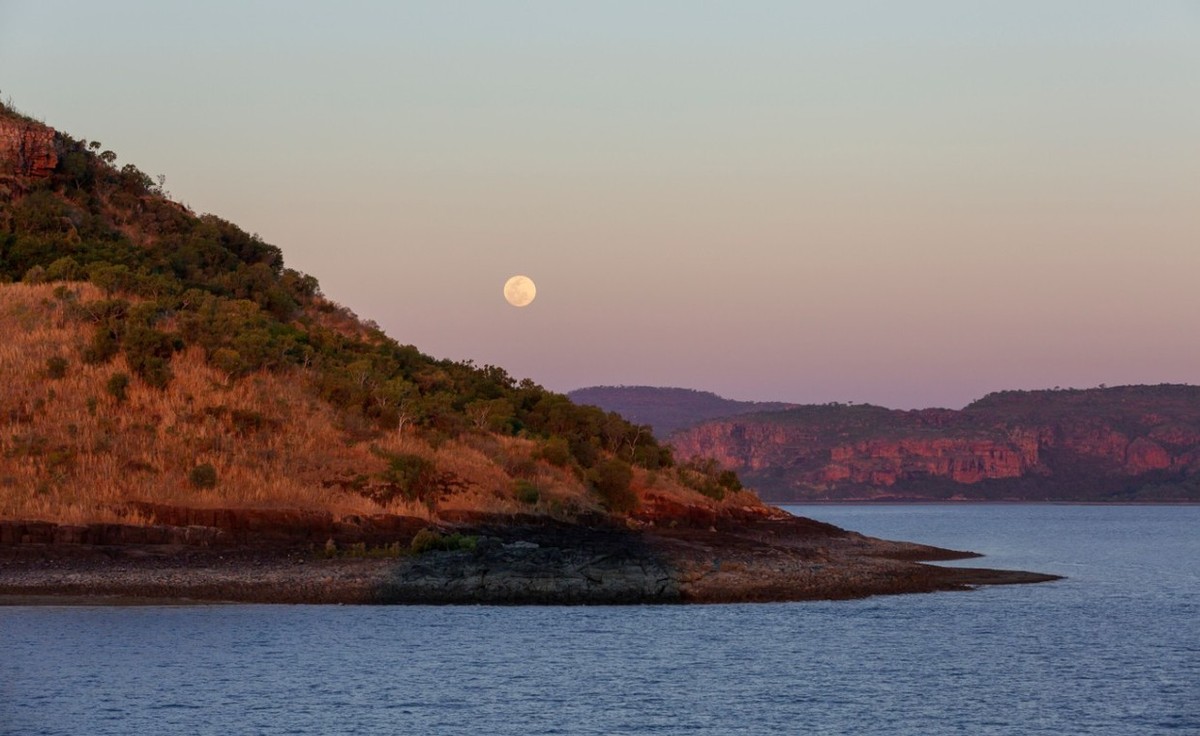
Ancient art, cliffs sculpted by the elements and sapphire blue waters welcome you to the spectacular Kimberley Coast. Bookended by tropical Darwin's charms, discover a coastline steeped in rich human heritage. Explore the mighty Buccaneer Archipelago's maze of islands, and marvel at Montgomery Reef, a marine wonderland unveiled by dramatic tidal shifts. A thrilling journey of close-quarter wildlife encounters and early Aboriginal artworks.
- Montgomery Reef – Watch the ocean recede to reveal a stunning marine ecosystem teeming with life.
- Buccaneer Archipelago – Navigate a breathtaking maze of islands sculpted by time and tides.
- Swift Bay – Discover ancient Aboriginal rock art hidden among dramatic coastal cliffs.
Availability is always subject to confirmation. Please check with us before booking flights
Prices quoted here are often dependent on currency fluctuations. Please check with (01432 507450 or info@small-cruise-ships.com) for the very latest price, which may well be cheaper than the one advertised here.
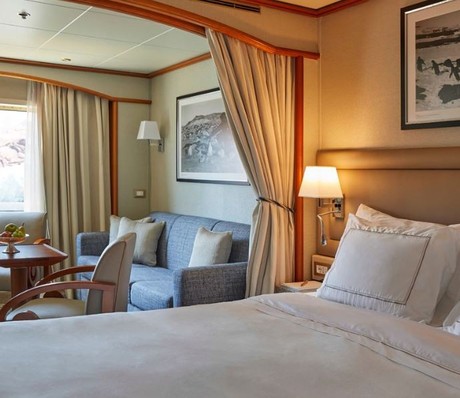
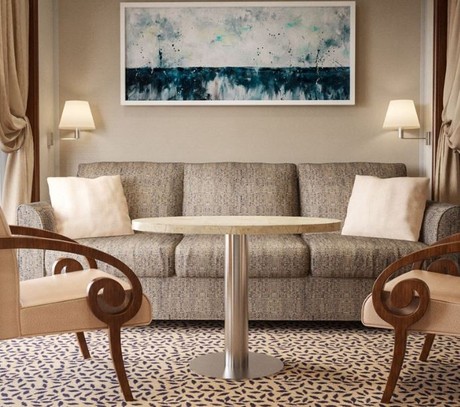
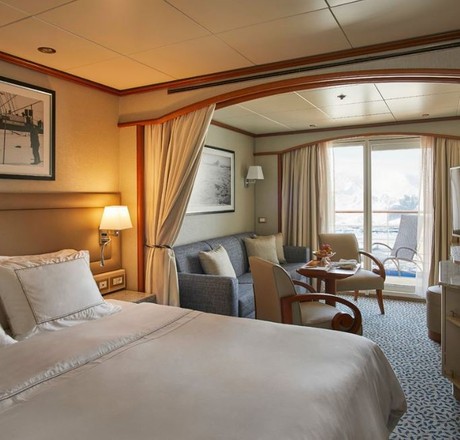
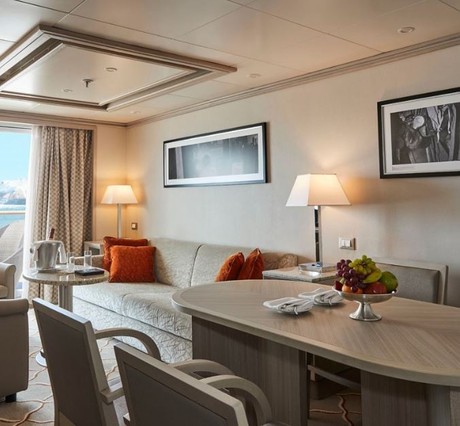
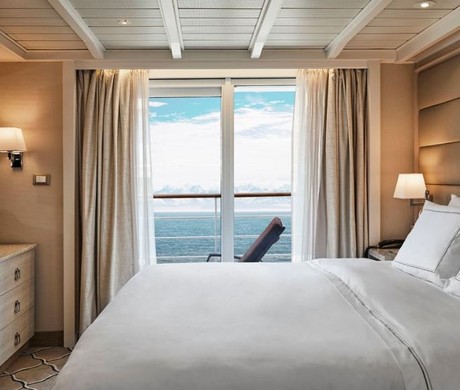

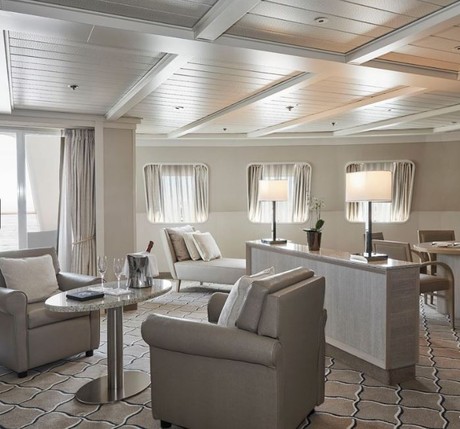
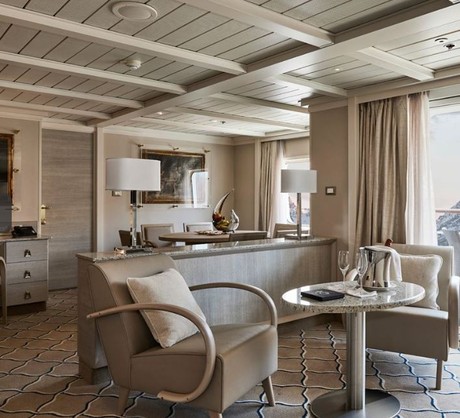



Prices quoted here are often dependent on currency fluctuations. Please check with (01432 507450 or info@small-cruise-ships.com) for the very latest price, which may well be cheaper than the one advertised here.











Pre Cruise Benefits
Private Executive Transfers
International flights - Economy class
or Business Class upgrade
Airport transfers
"Australia's capital of the north is a uniquely tropical city, and a historically isolated outpost of this vast, diverse country. Reaching up towards the equator, a full 2,000 miles from Sydney and Melbourne, the city was named in honour of Charles Darwin by the British settlers who established a frontier outpost here. With a unique history, beautiful islands nearby, and a palette of sizzling Pacific flavours, colourful Darwin is an enchanting and exotic Australian destination. Crocodiles patrol the jungled waterways and tropical rainforests around Australia's gateway to the Top End. Explore via airboat to look down on the veiny waterways of the mist-laced Kakadu National Park. The sounds of chattering birdlife and the gentle splash of fountains and waterfalls will fill your ears in George Brown Darwin Botanic Gardens. Soak it all in, before kicking back and relaxing with a picnic and a crackling barbecue. The sunshine and famous tropical pink sunsets mean many visitors naturally gravitate to the city's soft sands to relax at spots like pretty Mindil Beach, as evening approaches. The adjoining market is filled with souvenirs and crafts stands and is the perfect great place to enjoy some fiery Asian flavours. Stroll the stalls, grab some food, and crack open an ice-frosted beer as the sunset show begins. It may be remote, but Darwin found itself on the front line during the Pacific War, as the Japanese air force unloaded their bombs onto the city in 1942. This relaxed unassuming city has a deeply resilient backbone, however, and you can explore the museums to learn more of the war's impact on Darwin, as well as the devastating effects of one of Australia's worst natural disasters, Cyclone Tracy in 1973."
Koolama Bay is found at the mouth of the King George River. Named after the ship that had been beached here after a Japanese aerial attack during World War II, Koolama Bay is the starting point for a Zodiac cruise to reach the King George Falls, one of the Kimberley’s most magnificent natural wonders. At 260 feet (80 m), the twin cascades are among the highest in Australia. Koolama Bay and the river weaving through an amazing landscape of near vertical red rock formations will offer a parade of wildlife —saltwater crocodiles and amazing birdlife, including giant raptors and the Brahminy Kite.
Swift
Australia’s jaw dropping Kimberley region shelters some of the oldest collections of rock art. This ancestral art depicting warriors, animals or nature is an authentic testimony to Aboriginal’s culture, rituals and traditions. Tranquil Swift Bay offers you the opportunity to discover astonishing Wandjina art galleries and wake up the adventurer in you. A quick zodiac ride on the turquoise water gives you a chance to admire the coast’s spectacular scenery, while a short walk across the rocky and wild landscape - 250 meters from the landing site, leads you to the historic and artistic caves.In these ancient galleries, two different styles of rock art can be observed: the Gwion Gwion style, represented by long and skinny human-like figures and the much rounder Wandjina style. Both very impressive and special. You’ll need to keep your wits about you if you want to admire the most spectacular of the ancient paintings though, as it is painted on the ceiling and only visible by lying down. However, those with claustrophobia beware! the ceiling is only about a metre above your head. Those who do wiggle in to be the best position will fully appreciate the artwork’s enormous scale and size and surely won’t be left indifferent.
Lost in the immensity of Indian Ocean and situated 630 km of Broome, Ashmore Reef Marine Park is an Australian External Territory that covers 583 square km. With its diverse shades of blue, its underwater wonders and feathery friends, this protected area is one of Australia’s most beautiful natural treasures. The three tiny islands and their surrounding waters are home to an oasis of flourishing wildlife. Ashmore Reef is known to be the favourite place of more than 40 bird species. 100,000 seabirds breed there every year, including crested terns, white-tailed tropicbirds and greater frigatebirds. The islands are also a haven for thousands of migratory shorebirds like curlew sandpipers, bar-tailed godwits and great knots – some of them coming from very far places like Siberia! On the ocean side, the colourful reef is home to around 500 species of fish but also marine turtles, dugongs and many playful dolphins. Given the rich and fragile environment, Ashmore Reef has been declared a Sanctuary zone, providing the highest level of protection for the wildlife and minimising disturbance from human activities. Only scientific research is permitted but the visitors can access to the Recreational Use Zone, which includes a small area of the West Island, and thus discover this unique place.
Appearing like a charmed apparition, Adele Island is an oasis of tranquillity peeking out of the Indian Ocean. It’s hard to capture the sense of quiet perfection as you stand on this sandy paradise, 65 miles away from Kimberley’s rugged coast. The changeable sands of the island expand and contract with the contented sighs of the tides, and wide sandbanks ebb and flow with the whims of the water. At the core of Adele Island is a gorgeous tidal lagoon, rich in biodiversity. The island is a thriving ocean outpost for breeding birds and turtles, and the hospitable waters form a lively nursery for young humpback whales and bottlenose dolphins. Keep an eye out for large silhouettes sliding just below the shallow surface. The knee-deep sea here means you can easily spot wonderful sea creatures swimming agilely past. Keep your wits about you though, there may also be beady-eyed crocodiles, slaloming menacingly. Encounter beautiful sea turtles, diverse fish life, and remarkable birds like the lesser frigate bird and brown booby, all while exploring this pristine island gem. Stand in awe as plumes of seabirds rotate around you like a gentle whirlwind. Endless fields of immaculate coral reefs coat the seabed, alive like underwater cities, bustling with life and characters. With only the sounds of rhythmic waves sloshing, sandy footsteps crunching and vocal bird life singing out, melodic Adele Island hits all the right notes.
Set off the coast of Western Australia, the Buccaneer Archipelago is one of the Kimberley’s finest secrets. The Archipelago, 50 k2 (19 sq mi), is made up of around 800 islands and protect the mainland from the huge 12 metre tides and astonishing speed of the Yampi (or, in traditional Aborigine, “Yampee”) Sound. The speed and power of the water many not make for pleasant bathing, but do however result in fantastic natural phenomena. One fine example is the horizontal reversible waterfall in Talbot Bay. The tidal pull is responsible for the “reversible” nature of the falls, however, this also hides narrow gaps between the islands, making for treacherous sailing conditions. Isolated graves of sailors and divers are testimony to the danger. William Dampier sighted the Archipelago in 1688 but it would not be until 1821 that the Archipelago would become known as Buccaneer (a term coined by Captain Phillip Parker King) "in commemoration of William Dampier’s visit to this part of the coast ". Commander John Lort Stokes also noted the area in his 1838 record. Enterprising individuals were initially attracted to the Buccaneer Archipelago in the 1800s due to the superior pearling as well as the rich iron ore deposits. Pearling conducted by luggers in the 1880s was concentrated in Cygnet Bay, Cascade Bay, Cone Bay and Strickland Bay. More recently, mining operators established open-cut mines on Koolan Island on the east side of the Sound. Some of the richest iron ore in the world is extracted here to this day.
Adjacent to Montgomery Reef, but on the mainland, Freshwater Cove – locally known as Wijingarra Butt Butt. Aboriginal guides will welcome guests with a traditional ochre welcome on the beach. The rock formations that can be seen along the shore represent spiritual ancestors relating to the great Wandjina battle. Caves with rock art are found in the vicinity, but can only be visited with local guides.
Montgomery Reef, which is some 300 square kilometres in size, can show an amazing tidal change of up to 4 metres. When the tide drops, the reef seems to rise out of the water. At low tide a river is exposed that allows access to an amazing semi-submerged world. When the tide continues to ebb, Zodiacs will be used to make the way to the edge of the reef where one is surrounded by cascading waterfalls up to 3 metres high. Continuing up the river one is able to look at the abundance of reef birds and sea creatures including turtles and manta rays. A visit to Montgomery Reef is very much tide-depending, but truly a once in a lifetime experience.
The Hunter River is home to an immense mangrove system surrounded by soaring red sandstone cliffs. Narrow mangrove channels shelter numerous bird species, mudskippers, fiddler crabs and the infamous saltwater crocodile; the most aggressive crocodile species known to man. Naturalist Island at the mouth of the river has a stunning stretch of sandy beach that makes a perfect landing site for small helicopters that can pick up visitors wishing to explore some of the Kimberley’s vast interior. The highlight inland is the famous Mitchell Falls where four tiers of waterfalls plunge into deep pools that flow out into the mighty Mitchell River. The headwaters of the falls are cool and a dip in the fresh water is a welcome reprieve from the heat of the heartland.
Vansittart Bay is located near the northern tip of Western Australia. The bay was named by Phillip Parker King during one of his four surveys of Northern Australia during the early 19th century. Interesting parts of the bay include Jar Island and the opportunity to view Bradshaw (Gwion Gwion) and Wandjina styles of rock art. For these two different rock art styles there are two sites in close proximity.An area with an example of a more recent history is the Anjo Peninsula. A beach landing and a short hike across a lagoon or -depending on tides- a walk around the lagoon will lead to a World War II site. An almost intact wreck of an old airplane, a C-53, can be seen there.
"Australia's capital of the north is a uniquely tropical city, and a historically isolated outpost of this vast, diverse country. Reaching up towards the equator, a full 2,000 miles from Sydney and Melbourne, the city was named in honour of Charles Darwin by the British settlers who established a frontier outpost here. With a unique history, beautiful islands nearby, and a palette of sizzling Pacific flavours, colourful Darwin is an enchanting and exotic Australian destination. Crocodiles patrol the jungled waterways and tropical rainforests around Australia's gateway to the Top End. Explore via airboat to look down on the veiny waterways of the mist-laced Kakadu National Park. The sounds of chattering birdlife and the gentle splash of fountains and waterfalls will fill your ears in George Brown Darwin Botanic Gardens. Soak it all in, before kicking back and relaxing with a picnic and a crackling barbecue. The sunshine and famous tropical pink sunsets mean many visitors naturally gravitate to the city's soft sands to relax at spots like pretty Mindil Beach, as evening approaches. The adjoining market is filled with souvenirs and crafts stands and is the perfect great place to enjoy some fiery Asian flavours. Stroll the stalls, grab some food, and crack open an ice-frosted beer as the sunset show begins. It may be remote, but Darwin found itself on the front line during the Pacific War, as the Japanese air force unloaded their bombs onto the city in 1942. This relaxed unassuming city has a deeply resilient backbone, however, and you can explore the museums to learn more of the war's impact on Darwin, as well as the devastating effects of one of Australia's worst natural disasters, Cyclone Tracy in 1973."
Silver Cloud

| Refurbished: | 2017 |
|---|---|
| Crew | 212 |
| Tons | 17400 |
With 18-brand new Zodiacs, four superlative restaurants in Antarctica and a pole to pole expedition itinerary, Silver Cloud really does break the ice between expedition and luxury. Spacious yet intimate, designed to cross oceans and yet able to slip up rivers and into hidden harbours with ease, the yacht-like Silver Cloud carries just 296 guests in incomparable comfort and style. Combining spacious ocean-view suites and private verandas with stunning dining and entertainment options, Silver Cloud provides world-class cruise accommodations, service and amenities.
After extensive refurbishment, Silver Cloud is the most spacious and comfortable ice class vessel in expedition cruising. Her large suites, her destination itineraries and her unparalleled service make her truly special. Her four dining options will tantalise your taste buds and as 80% of her suites include a veranda, watching a breaching whale or a few cavorting penguins has never been so personal. She carries a limited number of guests in polar waters, meaning that Silver Cloud has the highest space to guest and crew to guest ratios in expedition cruising. With her 18 zodiacs, 10 kayaks, possibilities are almost limitless with ship-wide simultaneous explorations.
Deck plans are for illustrative purposes only – The actual ship and cabin layout may differ.
